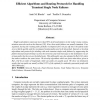Free Online Productivity Tools
i2Speak
i2Symbol
i2OCR
iTex2Img
iWeb2Print
iWeb2Shot
i2Type
iPdf2Split
iPdf2Merge
i2Bopomofo
i2Arabic
i2Style
i2Image
i2PDF
iLatex2Rtf
Sci2ools
98
Voted
CORR
2008
Springer
2008
Springer
Efficient Algorithms and Routing Protocols for Handling Transient Single Node Failures
Single node failures represent more than 85% of all node failures in the today's large communication networks such as the Internet [10]. Also, these node failures are usually transient. Consequently, having the routing paths globally recomputed does not pay off since the failed nodes recover fairly quickly, and the recomputed routing paths need to be discarded. Instead, we develop algorithms and protocols for dealing with such transient single node failures by suppressing the failure (instead of advertising it across the network), and route messages to the destination via alternate paths that do not use the failed node. This philosophy was also adopted in Ref. [14] where the authors address the same issues. We develop algorithms which are faster than those given in Ref. [14] by an order of magnitude, while our paths are equally good. We show via simulation results that our paths are usually within 9-12% of the optimal for randomly generated graph with 100-1000 nodes. KEY WORDS: N...
Related Content
| Added | 09 Dec 2010 |
| Updated | 09 Dec 2010 |
| Type | Journal |
| Year | 2008 |
| Where | CORR |
| Authors | Amit M. Bhosle, Teofilo F. Gonzalez |
Comments (0)

